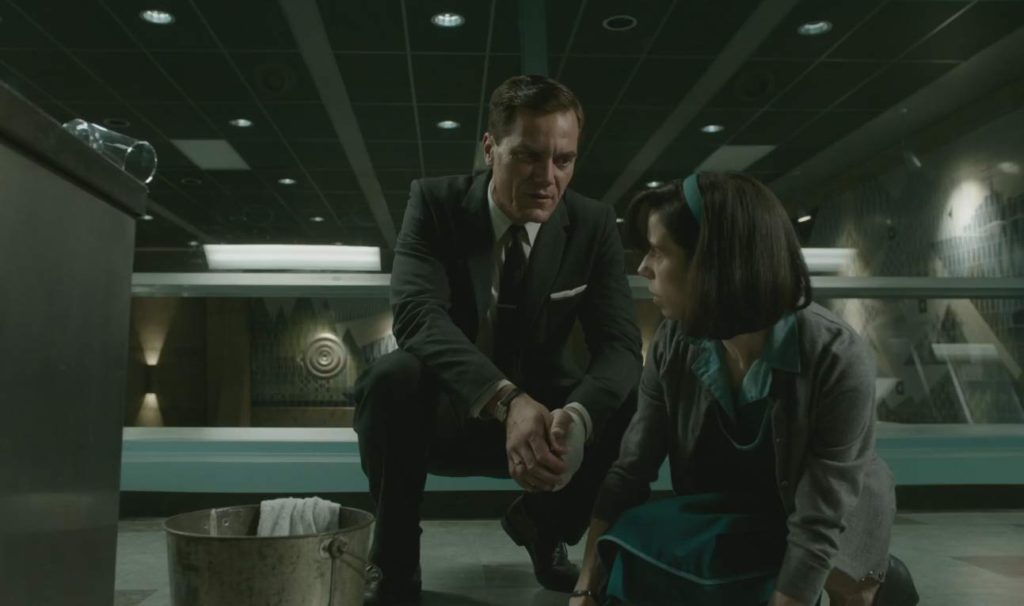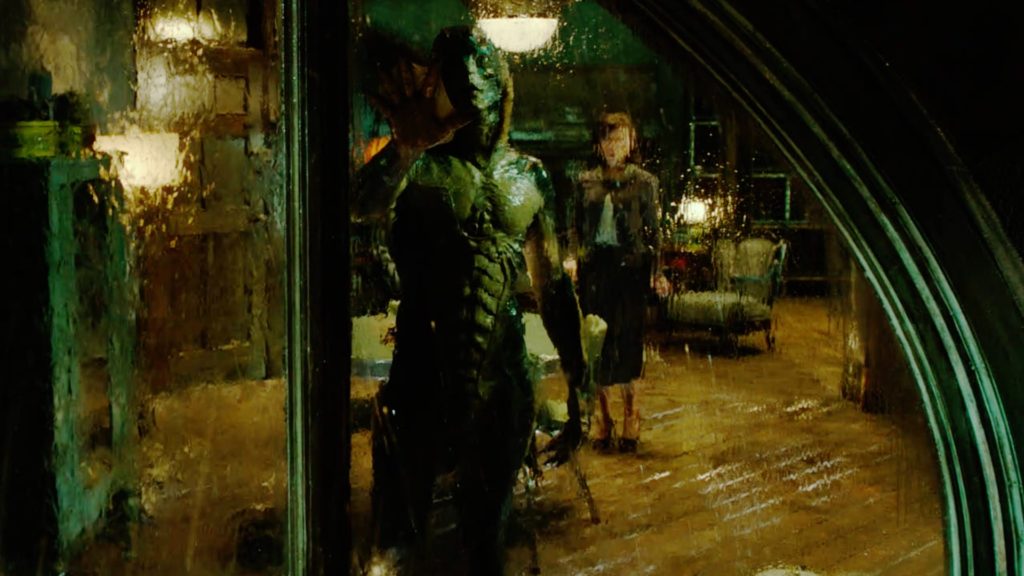Brimming with sensual yearning like sea foam at the edge of a dock, The Shape of Water is a peculiarly poignant parable from Mexican maestro Guillermo del Toro. The cult auteur behind some of the most adroitly constructed fantasy films of the last quarter century has always concerned himself with outsiders and miscreants, many of who find themselves incapable of properly articulating their loneliness or rage to the outside world. Yet with his tenth film, the director behind the Hellboy films and Pan’s Labyrinth makes the struggle for communication most explicit. The Shape of Water is a romance founded upon a forum of dialectics mediated via semiotics. In other words, tales, myths, legends and, yes, even movies, provide a connective fabric in an increasingly isolated and hostile world.
The cast of characters populating del Toro’s visually sumptuous recreation of 1960s Baltimore seem to have sprouted from archetypes that nevertheless carry within them a wounded humanity. Consider his heroine, a mute janitor named Elisa Esposito (Sally Hawkins). She lives alone above an old movie house and works as a custodian during the graveyard shift at a top-secret facility. Her days, or nights as they were, begin with a routine bordering on the ritualistic in her bathing in the tub and masturbating while a bowl of eggs are boiling on the stove, a timer ticking away on her sink. Already, with these aforementioned details, del Toro injects a bevy of metaphors and allusions through purely cinematic syntax. This earthy eroticism is conveyed not for titillation but as an affirmation of agency, both social and sexual, that many of del Toro’s heroes strive to retain in the carefully controlled microcosm they have constructed for themselves. A great deal of praise has to be given to the Casting Director Robin D. Cook for her work in getting Hawkins to play this role. Hawkins strikes a delicate balance in her nuanced performance that defies infantilization or objectification through the male gaze.

Indeed, one of the pleasures in del Toro’s script, which he co-wrote with Vanessa Taylor, is the way it’s female figures frankly discuss sexuality, often at the expense of the male ego. Elisa’s co-worker and confidant, Zelda (Octavia Spencer) waxes at length on her husband Brewster’s sexual virility to effacing effect. In another scene, she remarks upon the filthiness of the urinals in the men’s room. This rigid model of masculinity is upended by the discovery of the newest asset (as it is called by the scientists) of the facility; an amphibious humanoid (del Toro stalwart Doug Jones) fished out of the heart of South America by the square-jawed Col. Strickland (Michael Shannon). Elisa takes a burgeoning interest in the creature when it displays a penchant for the eggs she packs for her lunch, and she visits it practically during every break she takes. Yes, their attraction toward one another is initially anthropological, but it blossoms into a mutual respect and even something akin to love. Any question about the nature of their kinship being platonic is instantly put to rest by a sexual consummation later on, but I am getting ahead of myself. Without delving into too much detail, Del Toro makes this eventuality less about lust than a form of personal fulfillment, albeit to bestially kinky lengths.
Sampling the familiar tropes of Beauty and the Beast in all of its iterations, del Toro has his chauvinist villain in the form of Shannon’s candy-sucking G-man. Like his counterparts in the versions of the tale by Cocteau and Disney, Strickland is a brutish man exuding excessive arrogance as a means of compensating for his platitudinous buffoonery. Yet even he, as sadistic as he can be in his brutal treatment of the creature and his casual jingoistic bigotry, displays an ugly truth belying the ideal of the protean American Man. There is an exchange, late in the film, between Strickland and a commanding officer concerning “decency” and being “a good man” that serves to elucidate some of the character’s motivations. Strickland yearns to meet a standard set upon him by a rigid social framework. In a fundamental sense, his purchase of a teal-tinted Cadillac is borne from the same desire that governs the shy, gay artist (Richard Jenkins) living next door to Eliza or the scientist (Michael Stuhlbarg) acting as a covert spy for the USSR. All of these men find themselves constricted by the rules of the status quo of their respective social hierarchies, whether that is American or Soviet. The media they consume, in cinema and television, assumes a chimeric quality which provides for them a model to aspire to. Even an amiable quip from the scientist about Lenin paints the premier in deliberately incongruous terms. All of these characters are inundated with visions from a society that will never truly accommodate them.

I’ve devoted a great deal of this review to describing the cast of characters and the superb actors playing them. This does not necessarily detract from the pleasure of watching a familiar fable unfold at a confident rhythm, almost musical in it’s pacing. Truthfully, what del Toro is getting at here is an elaboration upon a familiar template utilizing his now trademark flourishes of vibrant reds and greens, clockwork mechanisms, and sudden jolts of violence. If there is a weak link in the film, it may be the actual romance between Elisa and the creature. This is not to knock the work of either Hawkins or Jones as much as it is a reflection on the limitation of the very conceit of the premise. In spite of its alluring physique, the creature does not transcend its status as a signifier of desire. When an emotional beat occurs within its periphery, this is due more to characters like Jenkins’ artist or Stuhlbarg’s scientist than from the creature itself. This is emphasized all the more by the abrupt ending that is conceptually feasible yet dramatically lacking.

“Maybe we’re both just relics,” the artist posits to the creature. This pondering of one’s place within a personal and cultural history is constantly referenced throughout the film, yet The Shape of Water urges us to look back to the past not as a form of nostalgia or even a cautionary warning for the future. Rather, it’s subversion of historicity is a testament to the power of myth, a power which ultimately diminishes the detachment symptomatic in an increasingly compartmentalized social schema. Rarely before has Guillermo del Toro’s untarnished love for the transformative political and spiritual power of storytelling been as explicit or as stirring as it is here. There is something to be said about what we gain from the little worlds of our own making, how our seemingly insular realities are strengthened, not diminished, by opening ourselves to the possibilities the greater world has to offer. Art and science occupy the same spectrum of discovery, and even if what we learn about the world can be ugly, del Toro argues that it nevertheless brings us closer to understanding ourselves and our potential. In that respect, The Shape of Water is a moving rebuke of the prevailing myopia seemingly ruling these turbulent times.
